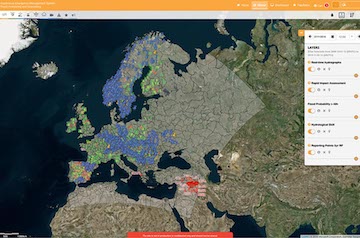
by CEMS-Floods Analytics and Dissemination Centre
On 16 June 2022 the CEMS-Floods Analytics and Dissemination Centre provided an EFAS and GloFAS training to Duty Officers at the Emergency Response Coordination Centre (ERCC) in Brussels. ERCC provides supports for natural hazards (including flooding, droughts, fires, earthquakes), humanitarian crisis (in conflict areas and wars) as well as other situations requiring international support such as the Covid-19 pandemics.
With regards to floods, the ERCC Duty Officers receive daily for Europe the "EFAS ERCC overview report" which shows a summary of active EFAS flood notifications as well as national information about forecasted and observed events, and globally standardised reports of observed flood events through GDACS. In case of an upcoming or ongoing large-scale flood event, the ERCC Duty Officers need to follow-up the information in more detail on the websites of EFAS and GloFAS.
The training was targeted to provide guidance on the products and the usage of the systems. In detail the following topics were covered:
- Forecasting chain and notification criteria
- Probabilistic scenarios and thresholds
- Forecast products (incl. Rapid flood mapping and assessment)
- Flash flood modelling
- Model performance and forecast skill
- Limitations of EFAS and GloFAS
The training was held both in presence and on-line,was provided by Assoc. Prof. Ilias Pechlivanidis, Project Manager of the CEMS-Floods Analytics and Dissemination Centre.
For EFAS, the presentation addressed the different types of flooding that EFAS assesses (fluvial and flash flooding) and the different types of notifications (Formal and Informal Flood Notifications, and Flash Flood Notifications) issued. This included a background on meteorological forecasting systems used, i.e. deterministic and probabilistic, and also on the criteria selected to issue notifications, including also the persistency and consistency in the forecasts. Specifically, for the EFAS products, the presentation focused on monitoring and ongoing situation, flood hazard forecast, flood impact forecast, and flash flood forecast. The model performance and forecasting skill were also explained.
The training continued with a presentation on GloFAS. It started with a summary of the GloFAS main characteristics and then focused on monitoring and ongoing situation, flood hazard forecast, flood impact forecast, and seasonal outlook. Finally, the presentation included information about the Global Reporting Tool (GRT) and its connection with GDACS (Global Disaster Alert and Coordination System).
The hands-on session on the EFAS-IS gave everyone the opportunity to explore all layers of the EFAS-IS and GloFAS-IS interfaces.
At the end of the training, a summary was provided while ERCC made suggestions for the evolution of the services. Overall, it was a successful mission to the ERCC and this type of training will be provided on a regular basis in the future.

